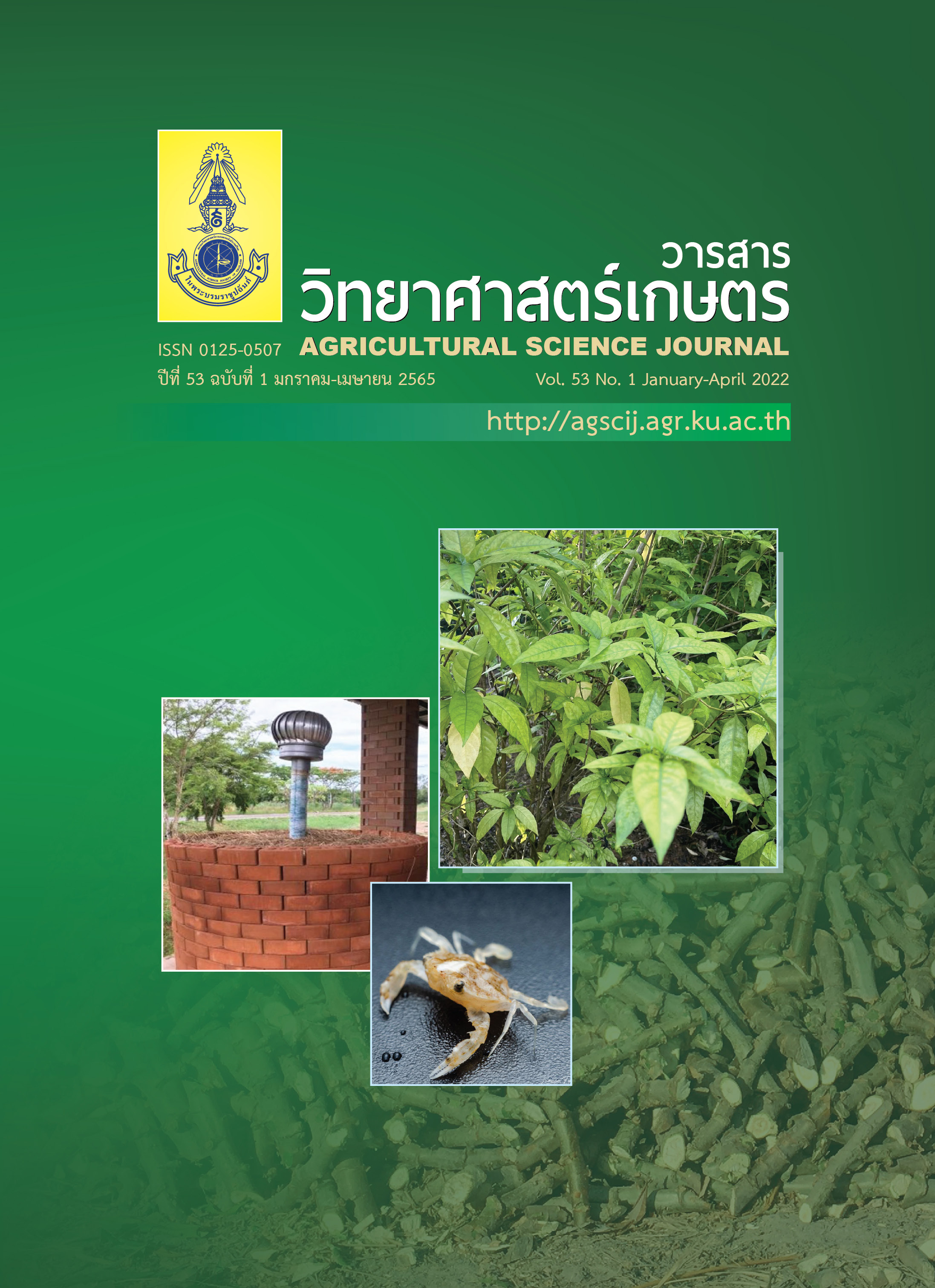Supplementation of Herbal Extracts and Juice Extract from Guava Leaves and Mint Leaves in Drinking Water on Broiler Performance and Meat Quality under Open Housing Condition
Main Article Content
Abstract
The objective of this experiment was to study the supplementation of herbal extracts and juice extract from guava leaves and mint leaves in drinking water on broiler performance and meat quality under open housing conditions. A total of 120 one-day old Ross 308 chicks were used and divided into 6 groups with 2 replications and 10 broiler chicks of each. They were assigned using a completely randomized design (CRD). Each group of chicks received different types of drinking water as follows: T1 = control (no additives), T2 = drinking water added with Herb of LoxinTM 1 cc/1L, T3 = drinking water added with bio complex 1 cc/1L, T4 = drinking water added with juice extracts from guava and mint leaves 50 cc/1L, T5 = drinking water added with juice extracts from mint leaves 100 cc/1L and T6 = drinking water added with juice extracts from guava leaves 100 cc/1L of water. The results of the broiler performance study showed that during the ages of 1–21 days, broilers drank water supplemented with juice extract from guava and mint leaves (T4) had a significantly higher production index (450.91 ± 9.06) compared to the other experimental groups (P < 0.05). At the age of 21–35 and 1–35 days, broilers drank water added with juice extracts from mint leaves (T5) had significantly higher body weight gain (BWG) and production index (PI) compared to control and the other groups (P < 0.05). The results of carcass quality and meat quality showed that there were no significant differences among groups (P > 0.05). However, supplementation of herbal extracts in drinking water affected on broiler performance, the supplementation of juice extract from mint leaves at the level of 100 cc/1L of water is the most effective and suitable to be used to increase broiler growth performance under open housing conditions during the age of 21–35 days.
Article Details

This work is licensed under a Creative Commons Attribution-NonCommercial-NoDerivatives 4.0 International License.
References
Al-Ankari, A.S., M.M. Zaki and S.I. Al-Sutan. 2004. Use of habek mint (Mentha longifolia) in broiler chicken diets. Int. J. Poult. Sci. 3(10): 629–634.
Baliga, M.S. and S. Rao. 2010. Radioprotective potential of mint: a brief review. J. Cancer Res. Ther. 6(3): 255–262.
Brenes, A. and E. Roura. 2010. Essential oils in poultry nutrition: main effects and modes of action. Anim. Feed Sci. Technol. 158(1–2): 1–14.
Bureau of Livestock Standards and Certification. 2020. Survey on Chemical Residues in Chicken in Thailand during 2017–2019. Available Source: http://certify.dld.go.th/certify/index.php/th, January 15, 2022. (in Thai)
Department of Livestock Development. 2021. Strategy of the Department of Livestock Development 2018–2022. Available Source: https://dld.go.th/th/images/stories/about_us/organization_chart/2561/strategy2561_2565.pdf, November 30, 2021. (in Thai)
Hongviwat, T. 2002. Food and Health in Culture. Sangdad Publisher, Bangkok, Thailand. 634 pp. (in Thai)
Jaturasitha, S., V. Leangwunta, A. Leotaragul, A. Phongphaew, T. Apichartsrungkoon, N. Simasathikul, T. Vearasilp, L. Worachai and U. ter Meulen. 2002. A comparative study of Thai native chicken and broiler on productive performance, carcass and meat quality. In Proc. of the Deutsher Tropentag 2002. International Research on Food Security, Natural Resource Management and Rural Development. Challenges to Organic Farming and Sustainable Land Use in the Tropics and Subtropics, 9–11 October 2002, University of Kassel-Witzenhausen, Witzenhausen, Germany.
Jaturasitha, S. 2007. Meat Technology. Department of Animal Science, Faculty of Agriculture, Chiangmai University, Chiangmai, Thailand. (in Thai)
Jirum, J. and P. Srihanam. 2002. Free radicals and antioxidants: sources and mechanisms of occurrence reaction. Kalasin University Journal Sciences Technology and Innovation. 1: 59–70. (in Thai)
Lutterodt, G.D. 1989. Inhibition of gastrointestinal release of acetylcholine by quercetin as a possible mode of action of Psidium guajava leaf extracts in the treatment of acute diarrhoeal disease. J. Ethnopharmacol. 25: 235–247.
Noppon, B., S. Khaeng–air, W. Chantarasanit and P. Noimay. 2003. Supplementation of lemon grass power in feeds on growth of native crossbred chickens. Thai J. Phytopharma. 10(1): 19–23. (in Thai)
Ocak, N., G. Erener, F. Burak Ak, M. Sungu, A. Altop and A. Ozmen. 2008. Performance of broilers feed diets supplemented with dry peppermint (Mentha piperita L.) or thyme (Thymus vulgaris L.) leaves as growth promoter source. Czech J. Anim. Sci. 53(4): 169–175.
Pudpila, U. 2011. Utilization of Peppermint (Mentha cordifolia Opiz.) as Feed Additive in Boiler Diets. MS Thesis, Suranaree University of Technology, Nakhon Ratchasima. (in Thai)
Rattanaphol, M., N. Rattanaphol and J. Puripattanawong. 2011. Use of guava leaf (Psidium quajava Linn.) and crude extract from guava leaf in broilers under evaporative cooling system, pp. 9–18. In Proc. the 49th Kasetsart University Annual Conference, 1–4 February 2011, Kasetsart University, Bangkok, Thailand. (in Thai)
SAS Institute Inc. 1989. SAS/STAT User’s Guide. Version 6. Vol. 2. 4th edition. SAS Institute Inc., Cary, N.C.
Siriwathananukul, Y., S. Watanasit and A. Itharat. 2010. Effect of Thai or Chinese Andrographis paniculata and Psidium guajava leaves on E. coli – diarrhea treatment of suckling pigs. J. Sci. Technol. MSU. 29(4): 389–403. (in Thai)
Sitthisuang, P. 2016. Effects of herbal supplements on broiler growth and meat quality. King Mongkut’s Agricultural Journal. 34(3): 117–125. (in Thai)
Skomorucha, I., E. Sosnowka-Czajka and R. Muchaka. 2020. Effects of supplementing drinking water with mixed herb extract or outdoor access on meat quality characteristics in broiler chickens. Ann. Anim. Sci. 20(2): 647–660.
Sriwiboon, W., W. Prapatsorn, O. Tantawiwat and W. Chiratchaweeyakul. 2004. The Use of Natural Herbs for Use in Cosmetics. Cosmetic Control Group, Food and Drug Administration, Nonthaburi, Thailand. 665 pp. (in Thai)
Tarachai, P. 2017. Poultry Production. Available Source: http://www.as2.mju.ac.th/E-Book/t_prapakorn/.pdf, February 13, 2022. (in Thai)


